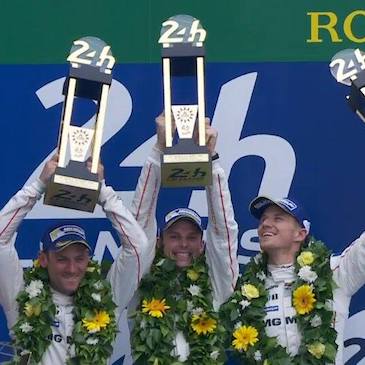Porsche took its seventeenth overall victory at the 24 Hours of Le Mans with an outstanding performance at the twice-round-the-clock race. Drivers Nick Tandy, Nico Hülkenberg and Earl Bamberg brought the #19 919 Hybrid home ahead of the #17 Porsche driven by Mark Webber, Brendon Hartley and Timo Bernhard and last year’s winners in the #7 Audi e-tron quattro of André Lotterer, Marcel Fässler and Benoit Tréyuler. The race was run at an astonishing pace, and it was Porsche’s mix of pace and reliability that proved to be the deciding factor.

As the tricolore fell on a warm and slightly muggy Saturday afternoon, it was the three factory Porsche LMP1 who – predictably – set the pace. The #18 led off the line, but the red-and-white-liveried #17 car driven by Timo Bernhard picked up the lead down the Mulsanne Straight and successfully defended it for the first half of the race. A safety car period one hour into the race bunched up the field again, with all the factory LMP1 cars (except the Nissans) mercifully behind the same train.
As the SC phase came to an end, it was like a re-run of the start, and the #7 Audi R18 e-tron quattro of André Lotterer was soon biting at the Porsches’ heels. He soon picked off Hülkenberg and Jani, and made a bee-line for Timo Bernhard at the head of the field. As we have become accustomed to over the past few years, Lotterer was consistently faster than all of his LMP1 competitors, and he soon snatched the lead away from the #17 car, now being driven by Brendon Hartley. However, the Audi suffered a puncture two and a half hours into the race, and the unscheduled pit stop put the car back down to fifth place ahead of the struggling Toyotas. Benoit Tréluyer took over the #7 machine, and was evidently at – and sometimes over – the limit in an attempt to gain back the time that had been lost.
The three-hour mark saw a major shake-up of the LMP1 order, with the #8 Audi driven by Loic Duval having a major incident on the run down to Indianapolis. A slow zone had been called by Race Control to recover debris at Indianapolis, but there was confusion in the field as a number of different GTE cars slowed to the required 80kph. Closing in on the slow section at racing speed, Duval underestimate the pace of the cars ahead and drifted right to avoid running into the back of them, before spearing left and making contact with the barriers. Thankfully, Duval was unhurt and made his way back to the pits for repairs.
After another hour under the safety car, the LMP1 field was unleashed once again, with Brendon Hartley leading the charge in the #17 Porsche. After the additional stop for the #7 car and the accident repairs for the #8 car, the #9 machine with Marco Bonanomi and then Filipe Albuquerque behind the wheel took up the challenge of hunting down the leading Porsches. In doing so, the Portuguese driver broke a race lap record that had stood since 1971 (a time when there had been no chicanes on the Mulsanne Straight) by posting a 3:17.647 (248.2 kph).
But the Porsche’s lead was such that it was able to retain its advantage during pit stops. It took until lap 84 – five and a half hours in – for the #9 Audi to whittle the lead Porsche’s lead down to a margin of under 40 seconds, and so Albuquerque became the third driver to lead the race when the #17 car pitted for fuel. At the six-hour mark, the #17 Porsche driven by Mark Webber led the race from Tréluyer (who would soon hand over to Marcel Fässler) in the #7 Audi and Albuquerque and then René Rast in the #9 Audi.
The Toyotas were unable to match the pace of the leading cars – some four seconds off throughout most of the race – and were already off the lead lap by this point, while Nissan by their own admission were treating the race as an extended test session. Rebellion were performing impressively in what was the debut for the new AER-powered car, sitting in 8th and 10th positions at the six-hour mark. The #13 car had lost time earlier on in the race after spinning on a Porsche GT car’s oil entering the first chicane and making contract with the Strakka-Dome LMP2 car. ByKolles had fallen behind the factory Nissans with engine troubles that would continue throughout the race.
As night fell, surprisingly it was Le Mans rookie Rast who showed the quickest pace, while his teammate Fässler in the sister car appeared to struggle. Rast gradually built up an advantage over the chasing Porsches over the next couple of hours but saw his advantage wiped away after eight hours with the start of another safety car period. The Porsches had been able to quadruple-stint their tyres in the cooler conditions, and the #19 car of Nico Hülkenberg came to the fore as the safety car was withdrawn after half an hour. He was battling Mark Webber in the #17 car, before pitting and leaving the #17 to take up the battle for the lead with the hard-charging #7 Audi.
Fässler and Webber delivered an incredible battle for the lead, with the two LMP1s passing and repassing each other almost every lap. The frenetic battle in the pitch black conditions was brought to a premature end, after the #17 was given a stop and go penalty for overtaking under yellow flags. Further down the pit lane, at Nissan, all three GT-R LM NISMOs had been running for the first ten hours of the race, but the #21 car driven by Tsugio Matsuda then suffered a problem with the front-right wheel and was forced to park it at Arnage.
At 2am, hour eleven signalled what proved to be one of the key stints in the race, with British driver Nick Tandy clambering into the #19 machine in place of Niko Hülkenberg. The rookie opened up a lead of one minute over the #7 Audi in just two hours of astonishingly quick and consistent driving. The temperatures also seemed to suit the Porsche over the Audi, with the normally lightning-quick André Lotterer not able to match the standard set by the #19 car.
At daybreak, New Zealand driver and Le Mans 24 Hours rookie Earl Bamber took over driving duties from Nick Tandy and matched the Brit pound-for-pound, reinforcing Porsche’s grip at the head of the field. The #19 car comfortably retained its one-minute lead, and the only real questions surrounded reliability on what had been a faultless run up to that point. But it was Audi who would suffer from car issues, with the rear bodywork on the #7 tearing off on the run down to the Ford Chicane, costing the crew a total of seven minutes in the pits and effectively ending their race challenge. There was some crumb of comfort for Audi: André Lotterer went on to take the all-time race lap record, beating the time Filipe Albuquerque set earlier on in the race, of 3:17.475 (248.5 kph).
As the race came to a close, the Porsches maintained a comfortable lead and, despite forecasts to the contrary, the chance of any significant rain seemed to be falling by the minute. Light sprinklings on the Mulsanne Straight and at Arnage saw Race Director Eduardo Freitas warn the teams of the slippery surface, but none of the LMP1s were forced to pit for intermediates. Agonisingly close to the end of the race, the #23 Nissan GT-R LM NISMO driven by Jann Mardenborough appeared to suffer a brake failure at the Porsche Curves and the car was retired. Still, Harry Tincknell brought the #23 car home, but it was too far behind the leaders to be classified.

Toyota had perhaps the toughest weekend of all the factory teams. Despite a genuinely flawless run, the #2 TS040 of Alex Wurz, Mike Conway and Stephane Sarrazin could only finish sixth, eight laps down on the winning Porsche. The gap translated to roughly 25 minutes on the track, and Toyota will be scratching their heads as to how the competition have such an advantage over them. The focus at Toyota in Cologne will surely now be on attempting to retain their world championships.
But it was who Porsche took its seventeenth victory at the Circuit de la Sarthe and, in Nico Hülkenberg, Nick Tandy and Earl Bamber, three new names were added to the role of honour. It had been a quite incredible performance from the Porsche 919 Hybrid, especially after reliability issues had plagued the team at the first two rounds of the FIA WEC season. The #17 car finished a deserved second, with the stop/go penalty proving to be a decisive moment in the course of the race. However, even without the penalty, the #17 car did not appear to be able to cope with its sister car’s pace. After another eventful race, the #7 car took third position and Audi’s sixteenth consecutive podium.
Image source: FIA WEC live stream / WEC-Magazin (James Clark)


